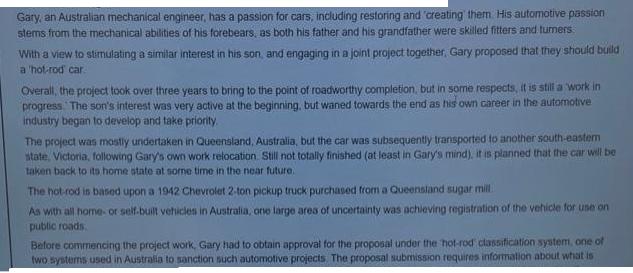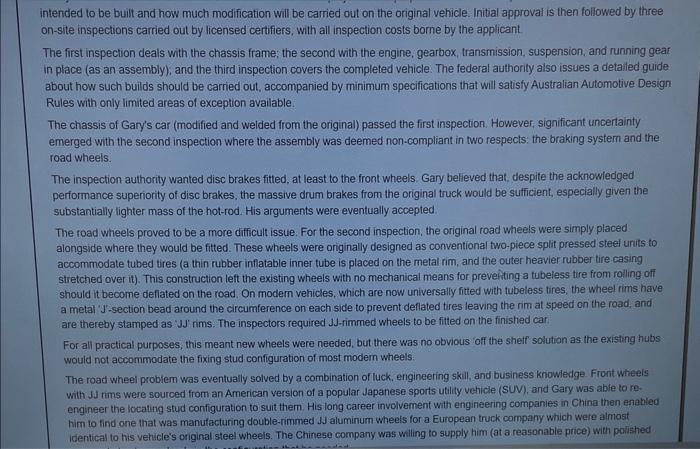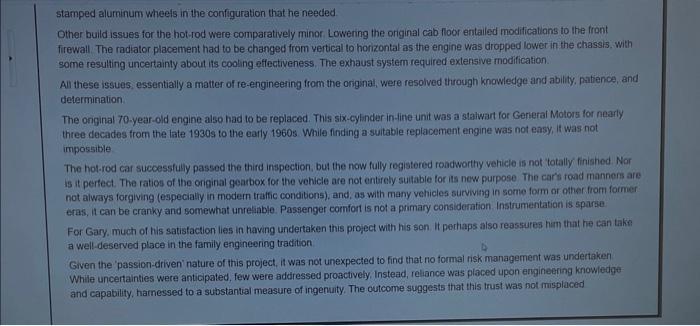Answered step by step
Verified Expert Solution
Question
1 Approved Answer
Gary, an Australian mechanical engineer, has a passion for cars, including restoring and creating them. His automotive passion stems from the mechanical abilities of





Gary, an Australian mechanical engineer, has a passion for cars, including restoring and creating them. His automotive passion stems from the mechanical abilities of his forebears, as both his father and his grandfather were skilled fitters and turners With a view to stimulating a similar interest in his son, and engaging in a joint project together, Gary proposed that they should build a 'hot-rod car Overall, the project took over three years to bring to the point of roadworthy completion, but in some respects, it is still a work in progress. The son's interest was very active at the beginning, but waned towards the end as his own career in the automotive industry began to develop and take priority. The project was mostly undertaken in Queensland, Australia, but the car was subsequently transported to another south-eastern state, Victoria, following Gary's own work relocation. Still not totally finished (at least in Gary's mind), it is planned that the car will be taken back to its home state at some time in the near future. The hot-rod is based upon a 1942 Chevrolet 2-ton pickup truck purchased from a Queensland sugar mill As with all home- or self-built vehicles in Australia, one large area of uncertainty was achieving registration of the vehicle for use on public roads. Before commencing the project work, Gary had to obtain approval for the proposal under the hot-rod classification system, one of two systems used in Australia to sanction such automotive projects. The proposal submission requires information about what is intended to be built and how much modification will be carried out on the original vehicle. Initial approval is then followed by three on-site inspections carried out by licensed certifiers, with all inspection costs borne by the applicant. The first inspection deals with the chassis frame; the second with the engine, gearbox, transmission, suspension, and running gear in place (as an assembly), and the third inspection covers the completed vehicle. The federal authority also issues a detailed guide about how such builds should be carried out, accompanied by minimum specifications that will satisfy Australian Automotive Design Rules with only limited areas of exception available. The chassis of Gary's car (modified and welded from the original) passed the first inspection. However, significant uncertainty emerged with the second inspection where the assembly was deemed non-compliant in two respects: the braking system and the road wheels. The inspection authority wanted disc brakes fitted, at least to the front wheels. Gary believed that, despite the acknowledged performance superiority of disc brakes, the massive drum brakes from the original truck would be sufficient, especially given the substantially lighter mass of the hot-rod. His arguments were eventually accepted. The road wheels proved to be a more difficult issue. For the second inspection, the original road wheels were simply placed alongside where they would be fitted. These wheels were originally designed as conventional two-piece split pressed steel units to accommodate tubed tires (a thin rubber inflatable inner tube is placed on the metal rim, and the outer heavier rubber tire casing stretched over it). This construction left the existing wheels with no mechanical means for preventing a tubeless tire from rolling off should it become deflated on the road. On modern vehicles, which are now universally fitted with tubeless tires, the wheel rims have a metal 'J'-section bead around the circumference on each side to prevent deflated tires leaving the rim at speed on the road, and are thereby stamped as 'JJ' rims. The inspectors required JJ-rimmed wheels to be fitted on the finished car. For all practical purposes, this meant new wheels were needed, but there was no obvious off the shelf solution as the existing hubs would not accommodate the fixing stud configuration of most modern wheels. The road wheel problem was eventually solved by a combination of luck, engineering skill, and business knowledge Front wheels with JJ rims were sourced from an American version of a popular Japanese sports utility vehicle (SUV), and Gary was able to re- engineer the locating stud configuration to suit them. His long career involvement with engineering companies in China then enabled him to find one that was manufacturing double-rimmed JJ aluminum wheels for a European truck company which were almost identical to his vehicle's original steel wheels. The Chinese company was willing to supply him (at a reasonable price) with polished stamped aluminum wheels in the configuration that he needed. Other build issues for the hot-rod were comparatively minor. Lowering the original cab floor entailed modifications to the front firewall. The radiator placement had to be changed from vertical to horizontal as the engine was dropped lower in the chassis, with some resulting uncertainty about its cooling effectiveness. The exhaust system required extensive modification. All these issues, essentially a matter of re-engineering from the original, were resolved through knowledge and ability, patience, and determination. The onginal 70-year-old engine also had to be replaced. This six-cylinder in-line unit was a stalwart for General Motors for nearly three decades from the late 1930s to the early 1960s. While finding a suitable replacement engine was not easy, it was not impossible. The hot-rod car successfully passed the third inspection, but the now fully registered roadworthy vehicle is not totally finished. Nor is it perfect. The ratios of the original gearbox for the vehicle are not entirely suitable for its new purpose. The car's road manners are not always forgiving (especially in modern traffic conditions), and, as with many vehicles surviving in some form or other from former eras, it can be cranky and somewhat unreliable. Passenger comfort is not a primary consideration Instrumentation is sparse. For Gary, much of his satisfaction lies in having undertaken this project with his son. It perhaps also reassures him that he can take a well-deserved place in the family engineering tradition Given the passion-driven' nature of this project, it was not unexpected to find that no formal risk management was undertaken While uncertainties were anticipated, few were addressed proactively. Instead, reliance was placed upon engineering knowledge and capability, harnessed to a substantial measure of ingenuity. The outcome suggests that this trust was not misplaced ACTIVITY STEPS To complete this assignment: 1. Read the scenario case (provided below). 2. Select and use one of the work breakdown models introduced in class. 3. Create a work break down structure for the scenario case. 4. Review your answers in a group debrief discussion led by your instructor ACTIVITY RATIONALE The purpose of this activity is to practice skills for creating work breakdown structures. Read the accompanying scenario and produce a work breakdown structure for the project described in the scenario.
Step by Step Solution
★★★★★
3.38 Rating (160 Votes )
There are 3 Steps involved in it
Step: 1
Based on your assignment instructions and the scenario given you are asked to read the case about Garys hotrod car project and then create a Work Brea...
Get Instant Access to Expert-Tailored Solutions
See step-by-step solutions with expert insights and AI powered tools for academic success
Step: 2

Step: 3

Ace Your Homework with AI
Get the answers you need in no time with our AI-driven, step-by-step assistance
Get Started


